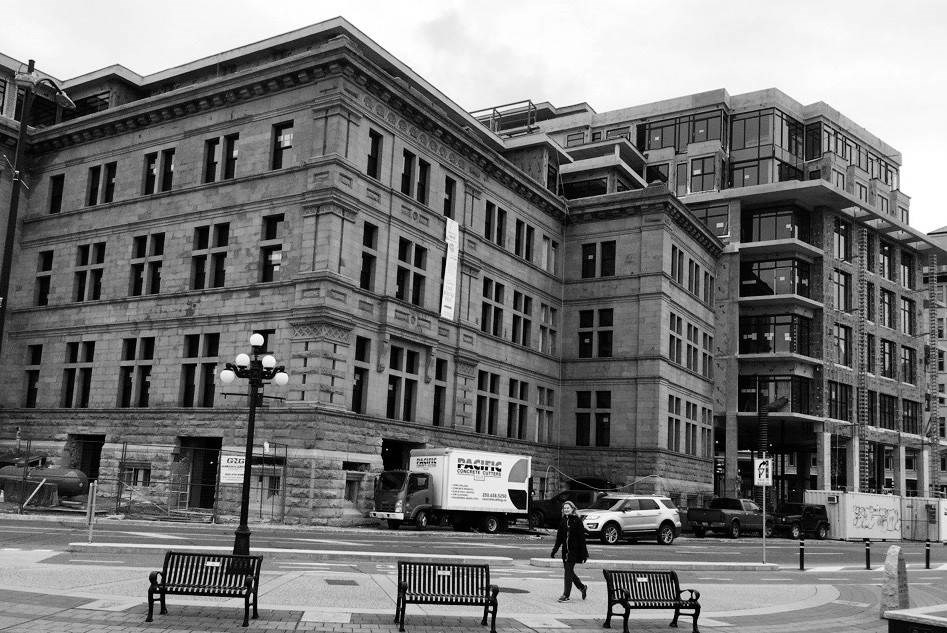I inherited my great grandfather’s pocket knife.
My grandfather replaced the blade.
My father replaced the haft.
I now own my great grandfather’s pocket knife.
It is authentic.
This dilemma of the authentic has bedeviled public discussion about preserving historic buildings since William Morris and John Ruskin founded the Society for the Protection of Historic Buildings in England in 1877.
When Michael Williams undertook his first restoration project, the William Grimms Carriage Factory on Johnson Street, partway into work on part of the building the entire front façade collapsed.
Architect Peter Cotton designed a new one, based on old photographs of the 1870s original. So, the building is not original. It’s new. The original design has been reconstructed.
So, what has this to do with a small assembly of European historic restoration experts who gathered in Athens in 1931 to professionalize what we call today “heritage conservation”? Their discussions were certainly an urgent response to what they deemed to be a major threat to historic monuments: the fast-rising popularity of new approaches to urban planning.
Scientific rationalism, under the generic heading of “modernism,” aimed to recreate the urban landscape of Europe, indeed the world.
This entailed not only the clearance of slums and renewal of decaying infrastructure, but ideally wiping the slate clean of the detritus of history, including the symbols of class, race, religion and nationalism that had fuelled generations of conflict, economic slavery, imperialism and autocracy.
The outcome of the Athens debates was the first international “Charter for Restoration of Historic Monuments.”
The men (and they were all men) at Athens sought an equally rational and scientific response.
First of all, the business of selecting monuments worthy of keeping, and then undertaking their restoration, was to be put into the hands of trained and knowledgeable experts. Secondly, as to adopting a scientific methodology for going about it, they looked to fine art restoration and the academic discipline of archeology for direction.
Professionals would decide which monuments were to be preserved based on age, rarity and quality. The goals of the ensuing treatment would be as with an object d’art, to keep it as whole as possible, and by doing so reveal the genius of its creation.
Scientific conservation came to Victoria with the work of Parks sa���ʴ�ý and the federal Historic Sites and Monument Board.
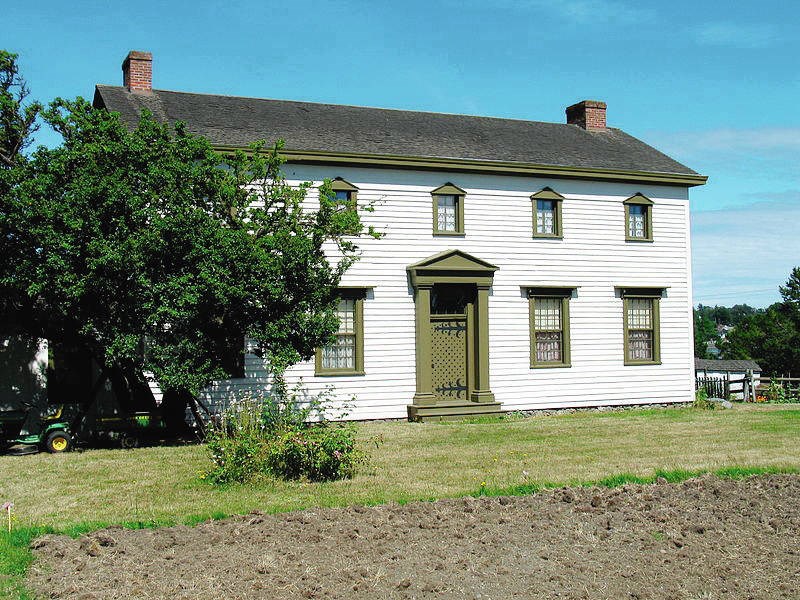
Craigflower Manor, the 1853 Hudson’s Bay Company farmhouse on the Gorge, was the subject of exhaustive research by professional historians and a thorough building investigation by local architect Peter Cotton.
Cotton’s meticulous “as-found drawings” set the standard for historic site documentation that remains to this day. These investigations determined the painstakingly accurate restoration of Craigflower Manor and the school house nearby.
Both are protected as provincial and national historic sites, designated in 1964 as symbols of early colonial settlement.
Despite the sense of panic felt by the Athens group, history did not unfold quite as they feared. Modernist grandiose plans such as those for vast radial cities promoted by a coterie of philosopher-urbanists such as Le Corbusier were slow to catch on.
Needless to say, massive destruction did follow, at the hands of the various belligerents who brought to bear the science of modern destructive ballistics.
However, when the smoke of the Second World War cleared, it was neither rational planning nor scientific conservation techniques that saw whole historic city centres rise out of the bomb-site ruins in Germany, Poland and Italy, but fastidious recreations of what was there before. Entire streetscapes, even buildings such as palaces and churches, were actually reconstructed surfaces pinned to new concrete cores.
These massive public works projects, underwritten by Marshall Plan funding or socialist economics, constituted a populist response to community demand, rebuilding social cohesion and national identities on a vast scale.
Faced with fakery running rampant according to the Athens ethical framework, a second meeting of experts was called for Venice in 1956. A new Charter emerged from these intense, mainly philosophical discussions.
The Venice Charter introduced the idea of context preservation in the urban setting, so a collection of buildings could be a heritage object in its own right.
Restoration practice should be based, not on the idea of buildings as art objects, but rather as documents that contain and reveal meaning or narratives. Restoration experts were, of course, empowered to read these meanings and make them visible.
In particular, what they did, or add, to the historic fabric of an historic building should be honestly expressed, that is, distinguishable from the original but not detracting from it. Thus, the popular recourse to “sympathetic infill.”
Victoria’s first Old Town full-scale restoration program, the brainchild of Mayor Biggerstaff Wilson in the early 1960s, and underpinned by federal urban renewal funding, was very much influenced by Charter of Venice thinking that was ultimately to be codified in Ottawa as the Standards and Guidelines for the Conservation of Historic Places in sa���ʴ�ý.
Using these guidelines as a reference from the early 1990s, the City of Victoria formally adopted the document as its restoration standard for designated buildings in 2005.
Saving Old Town began in the 1960s with a creative “paint up” of the older buildings to highlight the decorative details.
The centrepiece was Centennial Square, which the city’s first professional planner claimed would “preserve some of vanishing Victoria by accepting historic values and at the same time pointing the way to a progressive urban future.”
The most significant civic historic monuments, the city hall, police station and Pantages Theatre, were preserved. Secondary old structures such as the city market were levelled to create the stridently Modernist hard-surfaced Centennial Square. Additions to the historic building were also Modernist, but respectful in scale, detail and materials to the “monuments.”
Another major project under Venice Rules was Chinatown.
Based on the approach of the already well-received Bastion Square, essentially three city blocks were preserved, a network of private and public buildings and streets featuring Market Square, Fan Tan Alley and Fisgard Street, with views of the monumental Tong and Association buildings.
Unfortunately, the once distinctive multi-tiered balcony frontages, deemed a fire risk by the turn of the 20th century, were not reconstructed.
Contextual settings such as the landscaping of Fisgard Street were modernist “sympathetic decors” and the Gate of Harmonious Interests, completed in 1981, was conceived as an inspired recreation in permanent materials memorializing temporary celebratory processional arches erected in earlier times. Centennial Square and Chinatown were both popular successes and won numerous awards.
However, a later major intervention in Old Town (although the idea originated with the Wilson 1965 plan for Old Town as a needed economic anchor) was not. This was the massively scaled two-block Eaton’s (now The Bay) Centre completed in 1996.
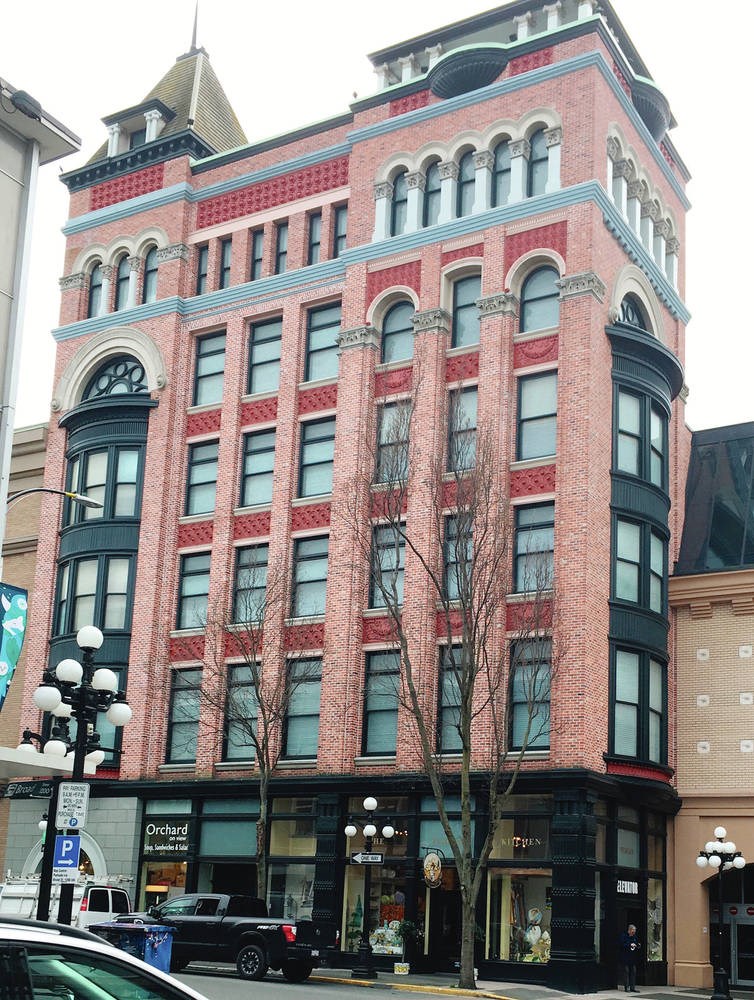
After acrimonious community debate, Cadillac Fairview, one of the biggest mall developers in the country, disrupted its normal mall formula: brutalist concrete fortresses built to capture and contain the retail shopper totally within.
For Victoria, street retail was inserted at the external edges on all sides. Street frontages of four extant heritage buildings were disassembled and reconstructed within street walls sporting a faux-Edwardian theme.
In this case, “facadism” became an easy summative rallying cry for a bundle of disruptive losses — a street given up, overwhelming scale, economic threat to traditional retailing patterns, along with traffic and pedestrian disruption during two years of construction.
The fact that entire historic cores of cities in Europe had and are being “recreated” utilizing similar approaches to heritage “restoration” was brushed aside. Admittedly, in this case, it was not belligerent bombing that had occasioned demolition.
But parallel to these developments, profound changes were underway in heritage-conservation thinking.
First was the democratization of the decision-making process itself in favour of those who live in the histories and own the memories they signify — the eventual realization by the professionals that while history may have happened, heritage is what we chose to make of it.
The second was debunking the notion that heritage buildings, and their parts, speak some sort of universal language like the aesthetics of modern architecture, easily decoded.
Even contemporary neurological science tells us our environment triggers emotional and mnemonic responses we project onto it, some learned from informed sources, some developed in shared community interactions. Thus, the popular attraction of ornament and symbolic forms.
The first major heritage conservation project to be community-driven was the rehabilitation of St. Ann’s Academy. The sa���ʴ�ý Provincial Capital Commission constituted an advisory committee of community members drawn from both stakeholder groups and the general community. The committee oversaw the research, planning and construction phases of the project.
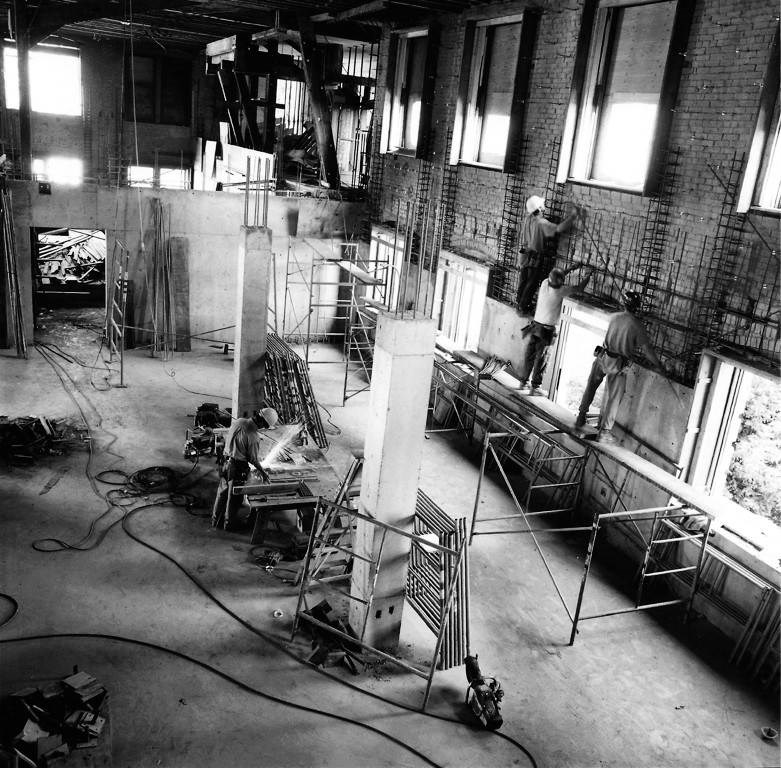
Under the committee’s direction, the buildings and grounds were restored to various significant dates in the history of the site. The main structure is actually a piece of massive façade stabilization. Except for the central entrance wing and chapel, the entire building was gutted, and a one-and-a-half storey basement and foundation system created under it.
A modern fully serviced poured-concrete office building was erected inside, to which the historic facades were pinned. When the failing brick envelope of the chapel was removed, the original pristine wooden-sided cathedral church was revealed.
This dated back to the time when it was a freestanding building on the north side of present-day Humboldt Street. However, because the interior of the chapel was recreated to the time of its early use by the Sisters of St. Ann, the brick exterior was reapplied. St. Ann’s has received heritage designation from all three levels of government.
Respecting the critical importance of community values in the identification and protection of heritage sites is a requirement of both the provincial and federal governments today.
Commemoration is based on extensive and detailed Statements of Significance developed and signed-off by community stakeholders. The SOS drives both the conservation and interpretation of the historic site.
Although Victoria has recently started to assemble SOSs for the buildings of Old Town, these have for the most part been done by experts, sometimes commissioned by the city but often by developers with a specific speculative interest in the site.
The lack of pre-existing community-based Statements of Significance for recent controversial projects such as the Wharf Street gold-rush warehouses and the Broad Street Duck’s Building has triggered community pushback aimed at these recent development proposals.
For instance, inside Duck’s, the once grandiose two-storey Knights of Pythias hall was not identified. And the adjacent sa���ʴ�ý Hotel, with a redolent local history but stripped of its ornament in the 1960s to modernize it, was not deemed significant at all, even though a 1993 study for the city recommended the restoration of its facades.
Added pressures on preserving Old Town’s as-built fabric are mounting. Recently, life-safety and seismic codes have significantly tightened. They are scheduled to tighten further.
The new step-code for meeting energy-efficiency targets has drastically impacted the choice of construction practices and materials. These requirements will involve more substantive alterations and changes to historic structures and higher levels of investment.
Decisions about what we preserve, to what extent, and how, are essentially a debate about community values. Buildings might be important symbols, documenting the lifestyle of an inhabitant, or just a link in a streetscape that tells the story of a homogeneous group of pioneer settlers.
These kinds of values will indicate what parts or to what extent a building should be preserved, or indeed whether or not it should be kept at all. It also means that often a whole block of street frontages should be treated, not as a series of individual facades, but as a monument with heritage integrity in its own right.
A controversial project of the moment is the redevelopment of the Dominion Customs Building and Post Office at the corner of Wharf and Government Streets.
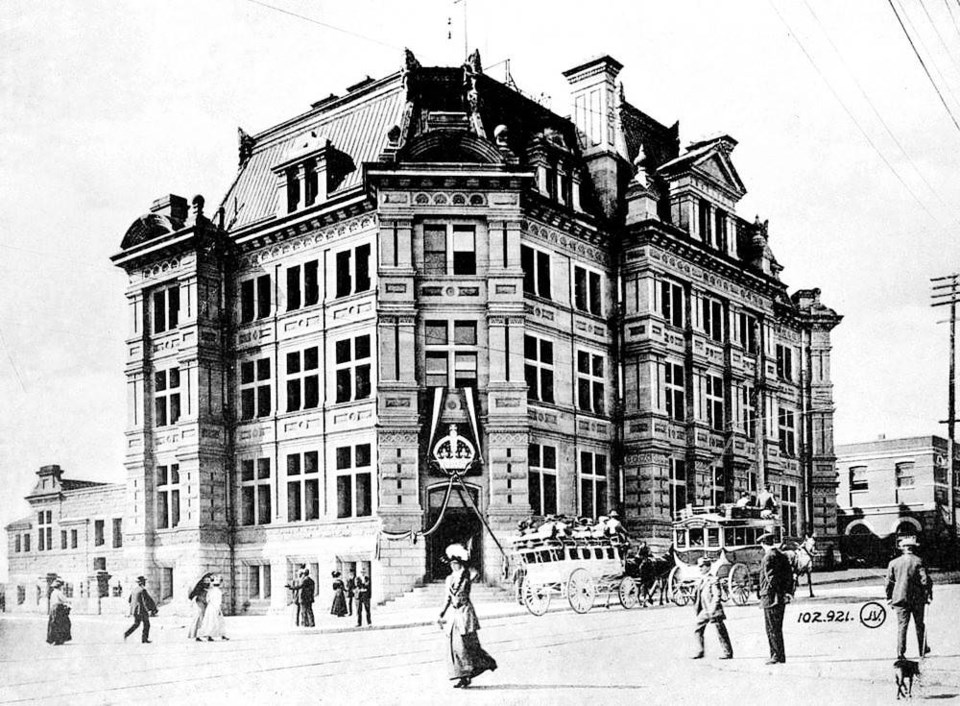
The federal-style 1896 Post Office had already received a Modernist International Style re-enveloping in the 1960s.
When the Inner Harbour was designated as the celebrations backdrop for the 1994 Commonwealth Games, the old Post Office Modernist façade was deemed so out-of-place that an outspoken community pressure group successfully petitioned the government to reclad it in a neo-classical skin, mostly fashioned from fibreglass.
The leader of the pressure group, Jim Munro, had just finished repurposing an Edwardian temple-bank nearby on Government Street as a bookshop,
When the current redevelopment of the block was proposed, did we lose a major opportunity? Could we have demanded the reconstruction of a critical element in the parade of historic monuments on the Inner Harbour instead of approving a modernist if “sympathetic” remake for the old Dominion Post Office abutting the preserved frontages of the former Customs House?
“Fake heritage” would have been the response of conservationist purists. Or “not the design language of our times!” — equally damning criticism from planning and architectural professionals.
Or perhaps it would have been dismissed as a “Disneyesque idea” by people on the street. Even the current effort to retain parts of the envelope of the adjacent Customs Building has seen the pejorative label “facadism” attached to the scheme.
The point is, for another generation, the story of the 19th-century power struggles among sa���ʴ�ý’s founding institutions, federal and provincial governments and the Canadian Pacific Railway, expressed so eloquently in brick and stone at our harbour entrance, will remain — missing a major chapter.
Martin Segger, a long-time resident of Victoria, is an architectural historian, two-term city councillor and former co-chair of the Provincial Capital Commission. He is a research associate at the University of Victoria Institute for Global Studies.
